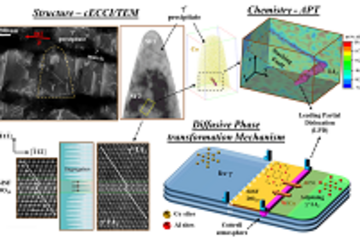All genres
2401.
Thesis - PhD
An investigation of hydrogen/microstructure interaction in complex nickel-based alloys: Multi-scale detection and embrittlement mechanisms. Dissertation, RWTH Aachen, Aachen, Germany (2017)
2402.
Thesis - PhD
Element redistribution and defect formation at the CdS/CIGS interface. Dissertation, RWTH Aachen, Aachen, Germany (2017)
2403.
Thesis - PhD
Influence of strain path changes during cup drawing on the twinning activity in TWIP steels investigated by ECCI. Dissertation, RWTH Aachen, Aachen, Germany (2017)
2404.
Thesis - PhD
Investigation of deformation mechanisms in magnesium crystals. Dissertation, RWTH Aachen, Aachen, Germany (2017)
2405.
Thesis - PhD
On the design of alloys and synthesis for composite steels. Dissertation, RWTH Aachen, Aachen, Germany (2017)
2406.
Thesis - PhD
Fundamentals of ferrous low-carbon lath martensite: from the as-quenched, to tempered and deformed states. Dissertation, RWTH Aachen, Aachen, Germany (2017)
2407.
Thesis - PhD
A Study on the Microstructure Formation Mechanisms and Functional Properties of CdTe Thin Film Solar Cells Using Correlative Electron Microscopy and Atomistic Simulations. Dissertation, RWTH Aachen, Aachen, Germany (2017)
2408.
Thesis - PhD
Grain boundary segregation in multicrystalline Silicon studied by correlative microscopy. Dissertation, RWTH Aachen, Aachen, Germany (2017)
2409.
Thesis - PhD
κ-carbide in a high-Mn light-weight steel: precipitation, off-stoichiometry and deformation. Dissertation, RWTH Aachen, Aachen, Germany (2017)
2410.
Thesis - PhD
Die Übertragung von mikrostrukturellen Eigenschaften aus der diskreten Versetzungsdynamik in Kontinuumsbeschreibungen. Dissertation, KIT, Karlsruhe, Karlsruhe, Germany (2017)
2411.
Thesis - PhD
Assessment of Co-free hardfacing stainless steel alloys for nuclear applications. Dissertation, University Manchester, Manchester, UK (2017)
2412.
Thesis - PhD
Mechanical properties in metallic glasses and their deformation mechanisms. Dissertation, RWTH Aachen, Aachen, Germany (2016)
2413.
Thesis - PhD
Elementary deformation processes during low temperature and high stress creep of Ni-base single crystal superalloys. Dissertation, Ruhr-University Bochum, Bochum, Germany (2016)
2414.
Thesis - PhD
Experimental-theoretical study of the interplay between deformation mechanisms and secondary phases in metastable β titanium alloys. Dissertation, RWTH Aachen, Aachen, Germany (2016)
2415.
Thesis - PhD
On the strain hardening mechanisms of a high-Mn lightweight steel. Dissertation, RWTH Aachen, Aachen, Germany (2016)
2416.
Thesis - PhD
Martensitic Stainless Steel: Evolution of Austenite during Low Temperature Annealing and Design of Press Hardening Alloys. Dissertation, RWTH Aachen, Aachen, Germany (2016)
2417.
Thesis - PhD
Transformation Phenomena during Quenching and Partitioning Heat Treatment. Dissertation, RWTH Aachen, Aachen, Germany (2016)
2418.
Thesis - PhD
Microstructure design via site-specific control of recrystallization and nano-precipitation. Dissertation, RWTH Aachen, Aachen, Germany (2016)
2419.
Thesis - PhD
Investigation of intermetallic layer formation in dependence of process parameters during the thermal joining of aluminium with steel. Dissertation, RWTH Aachen, Aachen, Germany (2016)
2420.
Thesis - PhD
Effects of strain amplitude, cycle number and orientation on low cycle fatigue microstructures in austenitic stainless steel and aluminum. Dissertation, RWTH Aachen, Aachen, Germany (2015)











